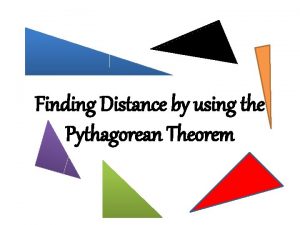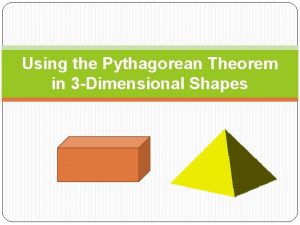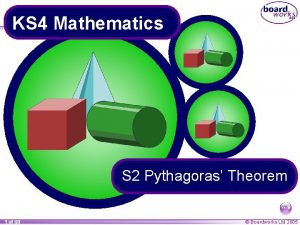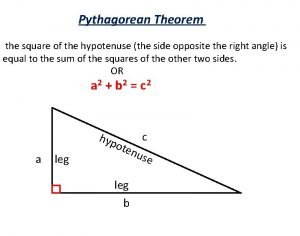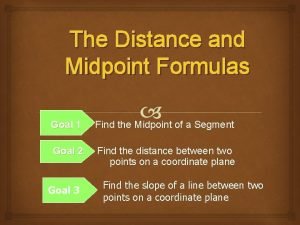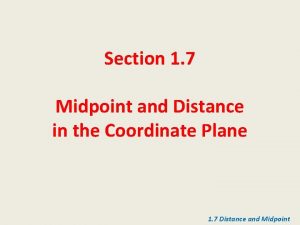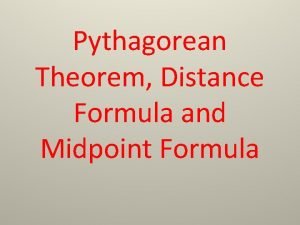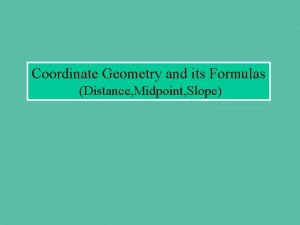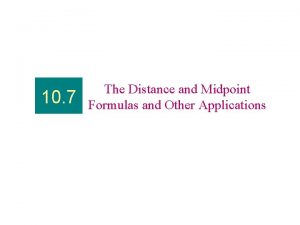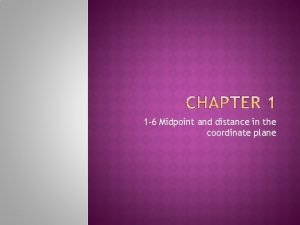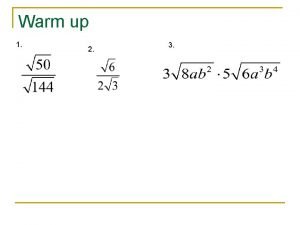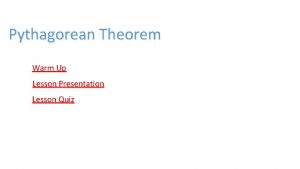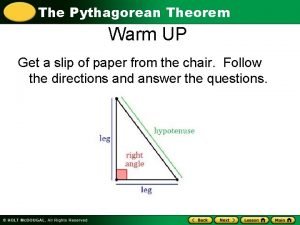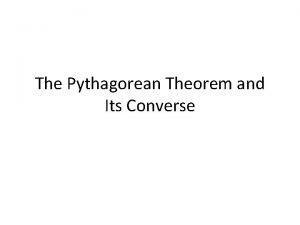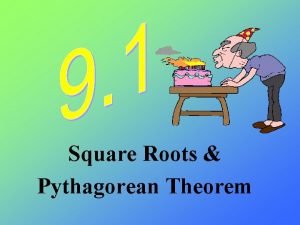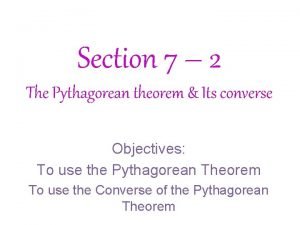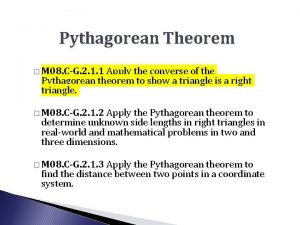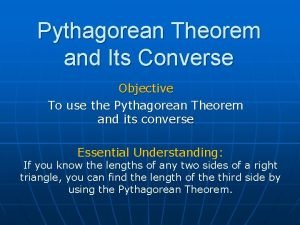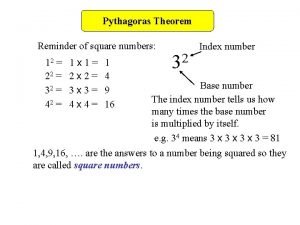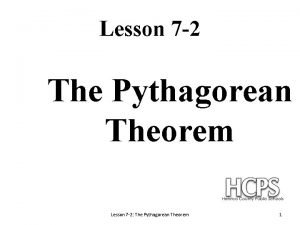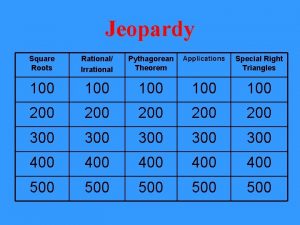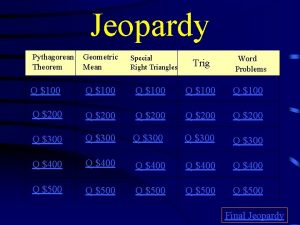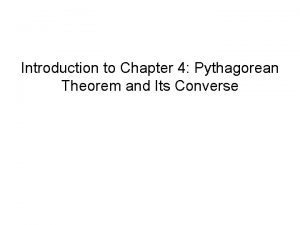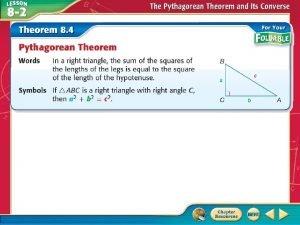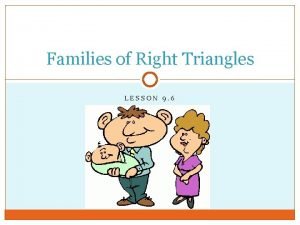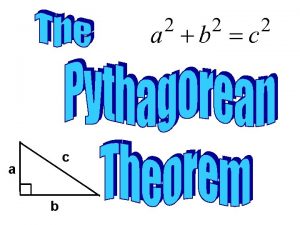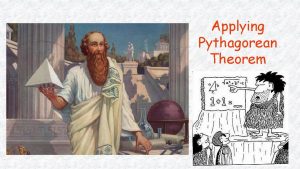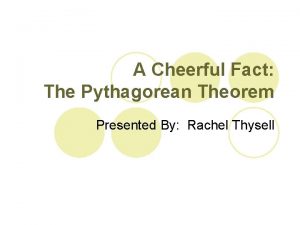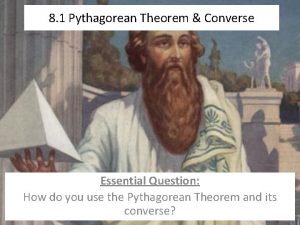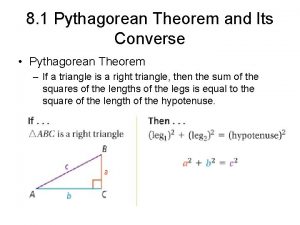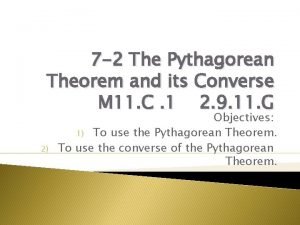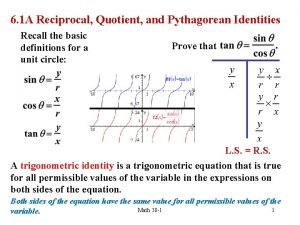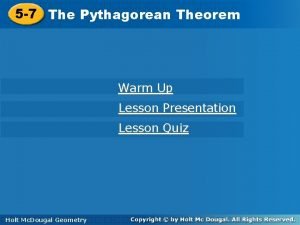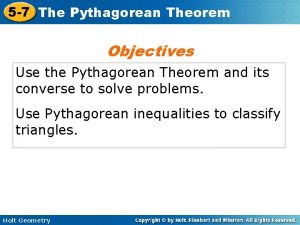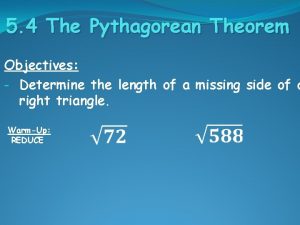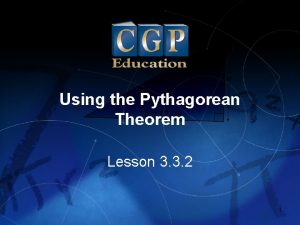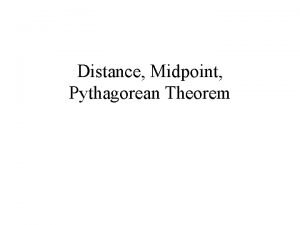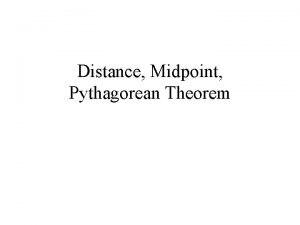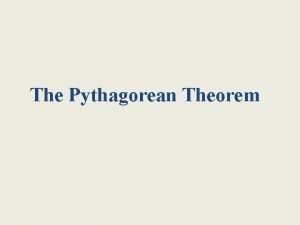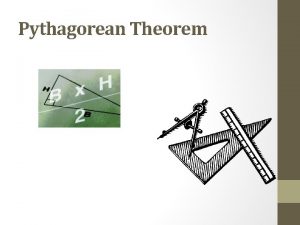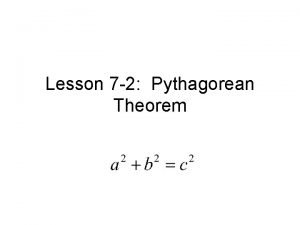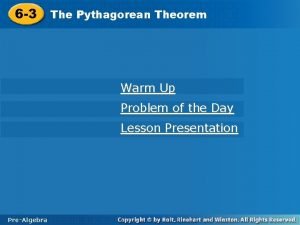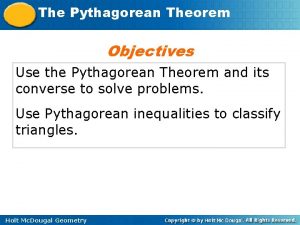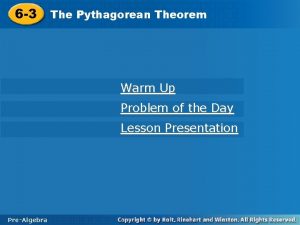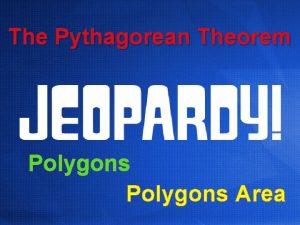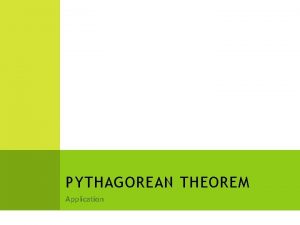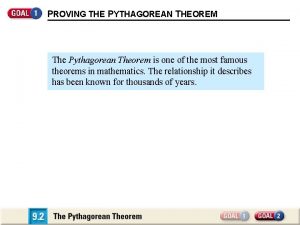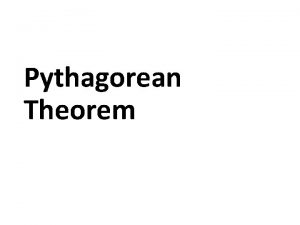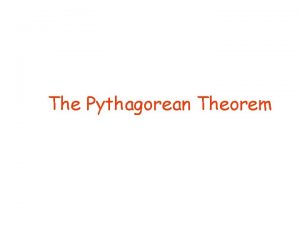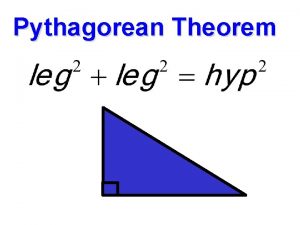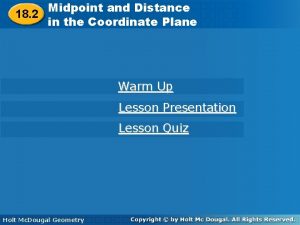Distance Distance Formula Pythagorean Theorem Midpoint Midpoint Formula

















































- Slides: 49

Distance • Distance Formula • Pythagorean Theorem Midpoint • Midpoint Formula • Fractional Location

You Will: • Find the distance & midpoint between two point on a number line. • Find the distance between two points in a coordinate plane using the Distance Formula and the Pythagorean Theorem. • Find the midpoint of a segment. • Locate a point on a segment given a fractional distance from one endpoint.

Success Criteria: 1) Simplify square roots 2) Find the midpoint on a number line and in the coordinate plane. 3) Find the other endpoint of a segment given the midpoint and one endpoint 4) Find the distance between two points on a number line and in the coordinate plane in simple radical form and rounded to nearest thousandth. 5) Find the fractional distance between two points in the coordinate plane.


District Formula (on Number Line) The distance between two points is the absolute value of the difference between their coordinates. Use the number line to find QR. The coordinates of Q and R are – 6 and – 3. QR = | – 6 – (– 3) | = | – 3 | or 3

Use the number line to find each measure.

Find BD. Assume that the figure is not drawn to scale. A. 16. 8 mm D 50. 4 mm B. 57. 4 mm C. 67. 2 mm 16. 8 mm B D. 84 mm C


Use the number line to find AX. A. 2 B. 8 C. – 2 D. – 8

The length of a drag racing strip is ¼ mile long; How many feet from the finish line is the midpoint of the racing strip? A. 330 ft B. 660 ft C. 990 ft D. 1320 ft 1 mile = 5280 feet

Helpful Hint To make it easier to picture the problem, plot the segment’s endpoints on a coordinate plane.

Find the coordinates of the midpoint of PQ with endpoints P(– 8, 3) and Q(– 2, 7). = (– 5, 5)

Find the coordinates of the midpoint of EF with endpoints E(– 2, 3) and F(5, – 3).




M is the midpoint of XY. X has coordinates (2, 7) and M has coordinates (6, 1). Find the coordinates of Y. Step 1 Let the coordinates of Y equal (x, y). Step 2 Use the Midpoint Formula: 12 = 2 + x – 2 10 = x 2=7+y – 7 – 5 = y The coordinates of Y are (10, – 5).

M is the midpoint of XY. X has coordinates (2, 7) and M has coordinates (6, 1). Find the coordinates of Y. The coordinates of Y are (10, – 5).

M is the midpoint of XY. X has coordinates (2, 7) and M has coordinates (6, 1). Find the coordinates of Y. The coordinates of Y are (10, – 5).

Let D be (x 1, y 1) and F be (x 2, y 2) in the Midpoint Formula. (x 2, y 2) = (– 5, – 3) Write two equations to find the coordinates of D.

Midpoint Formula Answer: The coordinates of D are (– 7, 11).

Two times the midpoint minus the other endpoint.

Find the coordinates of R if N (8, – 3) is the midpoint of RS and S has coordinates (– 1, 5). A. (3. 5, 1) B. (– 10, 13) C. (15, – 1) D. (17, – 11)

B • Add to x 1 if going right • Subtract from x 1 if going left • Add to y 1 if going up • Subtract from y 1 if going down A


Method 2 B 7 A C 6

M 3 N 4 R

M 8 (0, – 1. 3) N 6 R

8 N 1 M R (1, 2. 3) 12

M 5 N 5 (0. 75, 4. 75) R

Round to nearest tenth (-2. 2, -1. 4) (1, 2. 3) (0, -1. 3) (0. 75, 4. 75)

Locating a Point Given a Ratio (– 4, 6) 3. 6 4 C F(– 1, 3. 6) F 5


The Distance Formula & The Pythagorean Theorem

Helpful Hint To make it easier to picture the problem, plot the segment’s endpoints on a coordinate plane.


You can also use the Pythagorean Theorem to find the distance between two points in a coordinate plane. In a right triangle, the two sides that form the right angle are the legs. The side across from the right angle that stretches from one leg to the other is the hypotenuse. In the diagram, a and b are the lengths of the shorter sides, or legs, of the right triangle. The longest side is called the hypotenuse and has length c.

What do you call a tea pot used on Mt. Everest to make tea? Hypotenuse High pot in use

? 25 u 2 9 u 2 16 u 2

6 u 2

Use the Distance Formula and the Pythagorean Theorem to find the distance, to the nearest tenth, from D(3, 4) to E(– 2, – 5). Half the class will use the Distance Formula the other half will use the Pythagorean Theorem.

Method 1 Use the Distance Formula. Substitute the values for the coordinates of D and E into the Distance Formula. D(3, 4) to E(– 2, – 5)

Method 2 Use the Pythagorean Theorem. Count the units for sides a and b. a = 5 and b = 9. c 2 = a 2 + b 2 = 52 + 9 2 = 25 + 81 = 106 c = 10. 3

Use the Distance Formula and the Pythagorean Theorem to find the distance, from R to S. Leave in simple radical form. R(3, 2) and S(– 3, – 1) a = 6 and b = 3. c 2 = a 2 + b 2 = 62 + 3 2 = 36 + 9 = 45

Find the distance between (30, 15) and (80, 5).

On the back of your notes – 4 + 2 = – 2 5– 2=3 (– 2 , 3)

Q: What happen to the plant in the math classroom? A. It grew square roots.

Lesson Practice

(3, 3) (17, 13) 3. Find the distance, between S(6, 5) and T(– 3, – 4). Leave in simple radical form. 4. The coordinates of the vertices of ∆ABC are A(2, 5), B(6, – 1), and C(– 4, – 2). Find the perimeter of ∆ABC, to the nearest tenth. 26. 5
 Finding distance using pythagorean theorem
Finding distance using pythagorean theorem Pythagorean theorem three dimensions
Pythagorean theorem three dimensions Theorem pythagoras formula
Theorem pythagoras formula Identify
Identify Pythagorean theorem
Pythagorean theorem Pythagorean theorem formula
Pythagorean theorem formula Stokes theorem and green's theorem
Stokes theorem and green's theorem Lesson 5-1 distance and midpoint formulas
Lesson 5-1 distance and midpoint formulas 1-7 midpoint and distance in the coordinate plane
1-7 midpoint and distance in the coordinate plane Midpoint formula word problems
Midpoint formula word problems Slope midpoint formula
Slope midpoint formula Distance midpoint formula
Distance midpoint formula Midpoint and distance in the coordinate plane worksheet 1-6
Midpoint and distance in the coordinate plane worksheet 1-6 Pythagorean theorem warm up
Pythagorean theorem warm up Pythagorean inequality theorem
Pythagorean inequality theorem Pythagorean theorem warm up
Pythagorean theorem warm up The pythagorean theorem
The pythagorean theorem Pythagorean theorem and its converse
Pythagorean theorem and its converse Practice 11-2 the pythagorean theorem answer key
Practice 11-2 the pythagorean theorem answer key Inverse pythagoras theorem
Inverse pythagoras theorem 7-2 the pythagorean theorem and its converse
7-2 the pythagorean theorem and its converse Pythagorean theorem baseball
Pythagorean theorem baseball Converse of the pythagorean theorem worksheet
Converse of the pythagorean theorem worksheet 8-3 the converse of the pythagorean theorem
8-3 the converse of the pythagorean theorem Example of pythagorean theorem in real life
Example of pythagorean theorem in real life Pythagorean theorem numbers
Pythagorean theorem numbers The city limits of las pythagoras
The city limits of las pythagoras Which shows a right triangle
Which shows a right triangle Jeopardy rational and irrational numbers
Jeopardy rational and irrational numbers Pythagorean theorem jeopardy
Pythagorean theorem jeopardy 7-2 the pythagorean theorem and its converse
7-2 the pythagorean theorem and its converse Use the pythagorean theorem to find the missing measure.
Use the pythagorean theorem to find the missing measure. Pythagorean theorem families
Pythagorean theorem families Pythagorean theorem odyssey
Pythagorean theorem odyssey Pythagorean theorem volume
Pythagorean theorem volume Essential question for pythagorean theorem
Essential question for pythagorean theorem Applying the pythagorean theorem homework 3
Applying the pythagorean theorem homework 3 Facts about the pythagorean theorem
Facts about the pythagorean theorem Lesson 6 use the pythagorean theorem answer key page 427
Lesson 6 use the pythagorean theorem answer key page 427 Practice 8-1 the pythagorean theorem and its converse
Practice 8-1 the pythagorean theorem and its converse Converse of pythagoras theorem
Converse of pythagoras theorem Pythagorean theorem converse
Pythagorean theorem converse 7-2 the pythagorean theorem and its converse
7-2 the pythagorean theorem and its converse Trig reciprocal identities
Trig reciprocal identities Pythagorean theorem warm up
Pythagorean theorem warm up Lesson 5-7 practice b the pythagorean theorem answer key
Lesson 5-7 practice b the pythagorean theorem answer key Lesson 5-7 practice b the pythagorean theorem
Lesson 5-7 practice b the pythagorean theorem Pythagorean theorem objectives
Pythagorean theorem objectives Practice 11-2 the pythagorean theorem answer key
Practice 11-2 the pythagorean theorem answer key Pythagorean theorem study guide answer key
Pythagorean theorem study guide answer key
